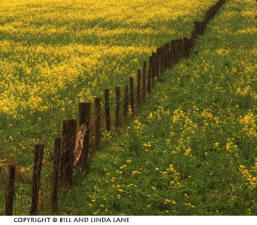
It is a gift not to be taken for granted when the work one loves in life evolves into a career that can be shared with a spouse.
Bill and Linda Lane enjoyed photography long before they became a couple. Bill’s embrace of nature and wildlife photography began more than 25 years ago as he sought a way to savor nature while pursuing a full time, physically demanding career as a farrier. He has been shoeing horses for the last 30 years.
Linda dabbled in photography as a means of financial support while in college. She also ran her own business for about 15 years. Later a friend introduced her to pottery and she was immediately hooked. A number of years later, she reacquainted herself with photography, met Bill in the process and the two have been working together behind the camera ever since. These days, they not only share with each other their love and joy of nature and wildlife photography, but also share it with others who wish to experience the beauty of nature while learning the art of photography in the process.
The Lanes started to hold photography workshops as a team 12 years ago. While organizing their workshops for the second year, the State of Virginia asked if they would be interested in promoting state parks by holding some of their workshops at lodges within the park system. That was such a perfect arrangement that now a third of their 10 to 12 workshops each year is held within state parks. The lodging is always comfortable and more than adequate. When food is not available, the Lanes provide home cooked meals. Meals, in fact, have become an important feature of some of their three-to-five day workshop packages. They are often told that folks come to the workshops as much for the home cooking as for the quality photography instruction! Of course, this is usually said in jest to give Bill a hard time. And, of course, even the best of meals never get in the way of taking photographs when the light is just right.
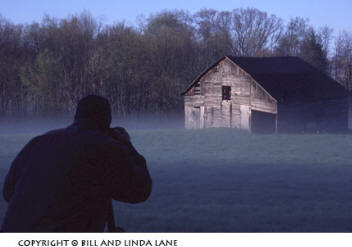
Bill and Linda work closely with each of their groups, one always taking up the slack or filling in for the other. They keep a watchful eye out for puzzled faces, noting topics that need further discussion, passing on questions and answers from one or the other to their participants, and helping budding photographers in the field fix their equipment problems. They locate images for those having a problem getting focused or offer hands-on help to those not sure what all the bells and whistles on their cameras are for. They set up demonstrations and try to make each location where they stop to shoot as convenient as possible. They complement each another so well that numerous students have commented, “It is definitely a team thing.” Bill and Linda know that one of them could not manage the workshop without the other. They are relentless in trying to fill the needs of each individual participant. Even the meals they provide attempt to cater to special needs.
“Without good participants, the workshops would be no fun. And if they are not fun, then they are not worth the effort,” Bill and Linda agree.
The Lanes describe how they sometimes look at one another while loading their VW camper van with three 150-quart coolers plus a couple other smaller coolers, food for the entire group for three to four days, plus assorted munchies, boxes of slides, projectors, screens, books, tripods galore, all their photography gear, water cooler and more – and wonder aloud why they are doing this.
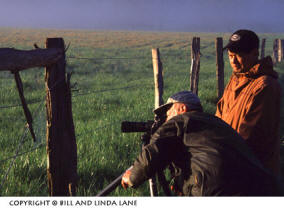
But once they arrive at their destination, unload their gear and set up, they begin to meet and greet their participants. As they look into the excited, anticipatory faces of those arriving for the workshop they quickly remember why.
“It never ceases to amaze us how wonderful each group of participants is,” Linda says. “After each workshop we think we just had the best group ever. But then at the next workshop we experience the same sort of wonderful, nature loving folks who are just there for a wonderful learning experience and we feel totally responsible for supplying exactly that. We really try.”
Bill and Linda seldom know what type of career their participants left behind. It doesn’t matter, they say. “These folks are here to learn about nature photography. They want to leave behind the hustle and bustle of the hectic lives that many of them lead. They are here to take pictures, add to their technical knowledge, learn about new locations, share, eat, sleep, relax and make new friends. Many come for the camaraderie as much as anything else. We know that our repeat guests, of which we have many, come for the entire package.”
Bill and Linda’s workshops have been described as holistic by some participants because they nourish the soul as well as the mind and body. This description came as a surprise to them at first but actually describes their workshops quite well. Each workshop is set in a comfortable learning environment. Bill and Linda strive to put people at ease so they are eager to ask questions. Bill says he wants to make the learning process easier and more fun than it was for him when he started. He wants to help people skip over the mistakes that most neophytes make. When he started, he had the best equipment money could buy, but lacked the knowledge to make it work for him. He wants people to ask questions, even if they are afraid of sounding “stupid.”
“There is no such thing as a stupid question,” Bill says emphatically. Bill is a born teacher and one of Linda’s most rewarding work experiences was her 10 years of teaching. Together, they strive to make the learning process as simple and fun as possible.
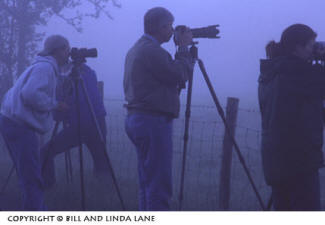
When possible, their workshops are conducted almost entirely outdoors, except for a critique session and a few slide shows meant to be both entertaining and educational. They are awake and out long before the sun rises in order to get in place for the early morning glow. Each afternoon, they stick around long enough to take advantage of the evening light. Each workshop day is packed as full as possible with as much shooting opportunities as can be scheduled in a day. When they ask participants if they are ready to take a break, the usual response is, “No, we came to shoot and learn. We can sleep at home.”
So, they, the class, stays at it, shooting pictures throughout each day. Participants learn about and get to put their hands on a variety of available equipment. They study creative composition, but more importantly, they learn about light and exposure – the one variable that can inevitably make or break a photograph.
From time to time, Bill and Linda have extended their workshops to four days to make the travel worthwhile for those coming from long distances and because there is just so much to do in so little time. Their Great Smoky Mountain workshop is the only one that lasts five days. The others are on weekends and begin on either a Thursday or Friday and go through noon on Sunday.
The Lanes try to keep the cost of lodging affordable. They don’t go after venues with 4- or 5-star ratings because participants are seldom in their rooms long enough to enjoy the amenities. Each package varies. Some rates include meals and lodging, others include lodging only and or instruction only. The only constant: homemade cookies are always part of the package.
The Lanes concentrate their workshops in seven states in the eastern United States. They feel they know the eastern states best and can therefore offer a wealth of pointers about where to go, what to see and what to shoot.
The Lanes live in Virginia, but have a getaway cabin in West Virginia as well. They like to take their classes to different places in search of the out-of-the-ordinary or to enhance the more familiar. Part of the experience is learning to see with a creative eye.
“When you take a group to a place and make them start to see the less than obvious picture, they love it,” Bill says. “You can actually see the light go on in their mind. We are all so programmed to see the obvious that we miss the picture within the picture, largely because we don’t allow ourselves enough time to stop and smell the roses. Learning how to see beyond the obvious is a thrill.” These weekend workshops are intended to allow participants to do just that.
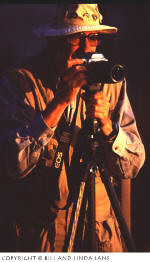 Bill and Linda’s programs are meant to inspire, but also to show examples of what they have been teaching in the field. “Nothing teaches better than a picture and an example of what you mean,” says Bill. Their programs are usually in a “show and tell” format. Bill and Linda present ideas, thoughts and techniques in as many different ways as possible, knowing that everyone learns in a different way. “What may make sense to one person may be Greek to another,” Linda explains. “So, the challenge is to present it in as many different forms as possible.”
Bill and Linda’s programs are meant to inspire, but also to show examples of what they have been teaching in the field. “Nothing teaches better than a picture and an example of what you mean,” says Bill. Their programs are usually in a “show and tell” format. Bill and Linda present ideas, thoughts and techniques in as many different ways as possible, knowing that everyone learns in a different way. “What may make sense to one person may be Greek to another,” Linda explains. “So, the challenge is to present it in as many different forms as possible.”
Another great aspect of the Lanes’ photo workshops is that they provide tripods for anyone who needs one – those who show up with a cheap one that simply won’t do the job, or others who are planning to purchase one but first want to experiment with different styles. Outside of the camera itself, a tripod is a most important piece of equipment a nature and wildlife photographer uses. Getting the right one requires considerable thought and deliberation. “You wouldn’t believe how many participants leave the class with a tripod as the first item on their ‘Got to Have’ list,” Bill says, noting that an astonishing number of workshop participants leave their old tripods in the trash before heading home.
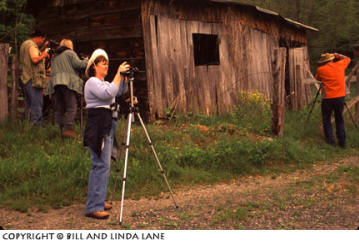
With all the new digital cameras around today, many workshop participants come with both digital and film cameras. There are still some — like the Lanes — who have not yet made the switch themselves but soon will. Nonetheless, Bill and Linda teach the use of digital cameras right along with instruction for film users. Since the critical task of capturing the right light is the same regardless of what type of camera is used, the instruction follows the same course. The challenge with digital photography is to help students learn to “take” good photographs to begin with – not to go back home to use their computer to “make” a poor picture good.
“No matter what type of camera you have, the rules of exposure remain the same,” Bill says. “Without understanding light, it is all hit or miss. You will bracket yourself to death. We cannot tell you how many folks have come to us and admitted that digital has been great fun, but it has made them lazy and that they are in class to get serious again and practice the basics.”
Bill and Linda Lane’s workshops are open to photographers at all levels of experience using film or digital cameras. Find more about their workshops by visiting their web site at: http://www.lanephotoworkshops.com, or call or fax them for a brochure at (804) 883-7740.

Leave a Reply